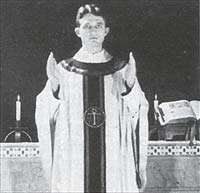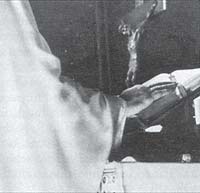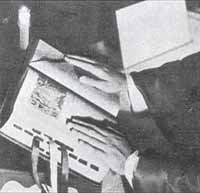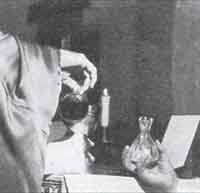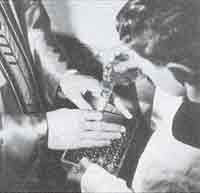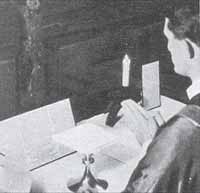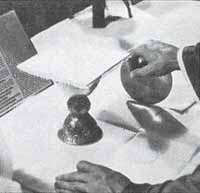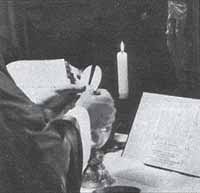A Liturgical Dictionary
|
PREPARATION OF THE FAITHFUL (FOR SUNDAY) Asperges "Thou shalt sprinkle me with hyssop, 0, Lord, and I shall be cleansed; Thou shalt wash me, and I shall be whiter than snow." Borrowed from 50th Psalm (the Miserere), the chant accompanies the sprinkling of the people with holy water done every Sunday before the High Mass. Each Sunday is another Easter celebration. The Asperges recalls the baptismal cleansing which made us participants in the sacrifice of the Mass. VIDI AQUAM "I saw water flowing from the right side of the temple (that is, from Christ's side opened on the Cross), alleluia; and all to whom that water came were saved, and they shall say Alleluia." Used to accompany the newly baptized on their way to participate for the first time in the sacrifice of the Mass, this song replaces the Asperges during the Paschal Season. PREPARATION OF THE CLERGY Prayers at the Foot of the Altar JUDICA ME A considerable part of the 12th psalm is used to prepare (formerly in the sacristy), the celebrant and the ministers of the Mass. It is a cry of longing uttered by a priest exiled a long time from the temple. CONFITEOR Finishes the preparation of the clergy, to which the people may unite themselves in private Masses. In a solemn Mass, the Confiteor should be combined with the Introit.
MASS OF THE CATECHUMENS 1. Praise and Petition P. INTROIT 1. The word means "He is entering" and indicates the antiphony, i.e., the refrain of a psalm, now considerably abbreviated, which was sung at the solemn entrance of the clergy making their way to the altar through the ranks of the faithful: The Introit is like the dramatic prologue of a poem–the Mass. To grasp the significance, listen to the melody. Better still, sing it. It is also helpful to read in entirety the Psalm from which the antiphon is taken the evening beforehand. KYRIE ELEISON "Lord–Christ–have mercy on us." Three times a triple invocation to call on the mercy of God. A remnant of the long litanies of the saints the people invoked during the processions in Rome while going in a body from the Church of the Collect where they were gathered. Also called the station church (still, generally indicated in the missal). The Mass is a sacrifice of unity. The people would not go to it separately with a mentality of individualism. Under the presiding Bishop with his priests in the church of the station (military term signifying a guard station), and led in the celebration of Holy Mass. Kyrie Eleison stems from the Greek language used at Rome in the early centuries ofthe Church: our Church is truly Catholic or universal. GLORIA IN EXCELSIS Song of praise to Christ and the Holy Trinity. The first words are those of the angels at the scene of the Nativity. The Gloria is now said or sung at all the Masses except during the penitential season, at ferial feasts, at votive Masses (selected privately for personal reasons). It is one of the most venerable canticles of the Catholic world. P. COLLECT First of the prayers peculiar and proper to each Mass. A request for spiritual or temporal graces for the Church, it is frequently related to the mystery or the saint celebrated on that day. Its name (which, means "gathering") derives from the fact that it was sung over the people gathered together in the church of the station, or also because it gathered together in the prayer of the celebrant all the demands and petitions which the people had formulated individually or privately. P. COMMEMORATIONS Prayers which are said after the Collect of the Mass of the day. They recall the existence of other feasts or Masses falling on the same day.
2. Readings P. THE EPISTLE "Letter." A fragment of one of the letters of an apostle is read from Sacred Scripture. Outside of Sunday Masses, the reading might be a selection from any book in the Bible except the Gospels or the Psalter. P. GRADUAL Portion of a psalm formerly sung as a solo from the steps of the pulpit from which the Epistle was read. It is a peaceful meditation following upon the reading of the Epistle. P. ALLELUIA Song of praise which hails the coming of Christ in the Gospel. P. TRACT Replaces the Alleluia during the penitential seasons. Originally it consisted of a psalm sung as one "tract" without responses or repeats.
P. THE GOSPEL Portion of the life or of the teachings of Christ. The climax of the Mass of the Catechumens. THE CREDO A profession of faith in the truths, taught by the Epistle and the Gospel. Sung or recited Sundays only and on certain important feasts. THE MASS OF THE FAITHFUL: 1. Offering of the Matter for the Sacrifice OFFERTORY
The word includes three elements
P. THE SECRETS
Prayers said by the priest to ask of God that He regard the offering favorably and grant the fruits thereof. The word "secret" emphasizes the fact that we are being introduced to the Canon of the Mass which formerly was known by the term "secrets," i.e., mysteries. 2. Consecration PREFACE The word does not only designate a prelude but also the solemn beginning of the Consecration. It is a giving thanks (Glorification of God) by means of which we ask Him to associate us to the praise of the angels. SANCTUS Chant of the angels which reminds us of the incomparable holiness of God about to be present among us.
CANON "Rule." (A rule regulating the Eucharistic action which takes place in the Mass). The Canon actually begins with the Preface and ends with the Amen which precedes the Paster Noster. Its chief elements are a) Te igitur...., b) In Primis ..., c) Memento of the living, d) Hanc oblationem, e) Quam oblationem. The parts a, d, and e request that God accept favorably this sacrifice. Part b makes intercession in behalf of the entire Church. Part c recalls all those who are dear to us and to whom we wish to recommend to God. CONSECRATION Essentially it consists of the words and acts of the institution of the Eucharist by Jesus at the Last Supper by which bread and wine are converted into our Divine Lord's Body and Blood (transubstantiation). By the mouth and the hands of the priest, Jesus represents both the words and gestures which He performed at the Last Supper: where He offered Himself under the appearance of bread and wine in perfect homage to His Father for the salvation of men and their union (their alliance) with God. ELEVATION The presentation of the Body and Blood of Christ for the adoration of the faithful. The essential part of the Mass is not yet completed. The sacrifice of the Son still must be offered to the Father in memory of the Passion, the Resurrrection and the Ascension of Christ (Unde et memores...) We ask that God look as favorably upon this sacrifice as He did on the sacrifices of the Old Testament, which were its forerunners.(Supra Quae...) We further ask Him to unite our sacrifice (our offerings and ourselves) to the sacrifice of heaven (Supplices te rogamus). Then follow more prayers of intercession: for the deceased (Memento) and for ourselves (Nobis quoque peccatoribus), and a blessing on our offerings (Per quem haec omnia...). MINOR ELEVATION At last, the conclusion, the climax of the Canon (Per ipsum...): the offering of the complete sacrifice of His Son and of oursleves, members of His Son, to the Father.
3. Communion PATER NOSTER Preparation for Communion. A request for daily bread; forgiveness of sins. THE BREAKING OF BREAD The act, which in olden times designated the entire Eucharistic celebration is performed during the saying of the Libera. The Libera expands upon the petitions of the Pater Noster. THE MINGLING OF THE HOST AND THE CONSECRATED WINE Another symbol of unity. The priest lets a tiny particle of the host fall into the chalice. In former times a fragment of the host of the Mass of the preceding week was joined to the sacrifice of the day. This is still done at the Mass of the Presanctified on Good Friday.
COMMUNION First, Communion of the priest as the representiative of the people. Then, Communion of the people. "Communion" does not imply merely union of the individual with God but also union of all the faithful at the same banquet. The vivified Flesh of the resurrected Divine Lord Jesus Christ heals and stregthens us. CONCLUSIONS ABLUTIONS The priest washes and wipes his fingers and the sacred vessels. During this action, the Communion is chanted. P. THE COMMUNION Refrain and the only remnant of a psalm formerly sung during the Communion procession. It is a verse of a psalm from the Gospel, chosen because of an allusion to the Eucharist and generally recognizable as such. P. THE POSTCOMMUNION Prayer sung by the priest requesting that the mysteries of which we have been partakers influence our conduct for the immediate future and for eternity. ITE, MISSA EST "Go, the assembly is dismissed." The signal for departure, meaning we are to go and live the Mass. It is replaced by Requiescat in pace (May they rest in peace) at Masses for the faithful departed, because the faithful are to remain for another part of the burial service. BLESSING OF THE PRIEST Last gesture of dismissal. LAST GOSPEL The Prologue of the Gospel of St. John is recited, not as a lesson but as a thanksgiving. 1. Words prefixed by the letter "P" indicate the parts of the Mass contained in the Proper of the missal. They vary almost every day. |
